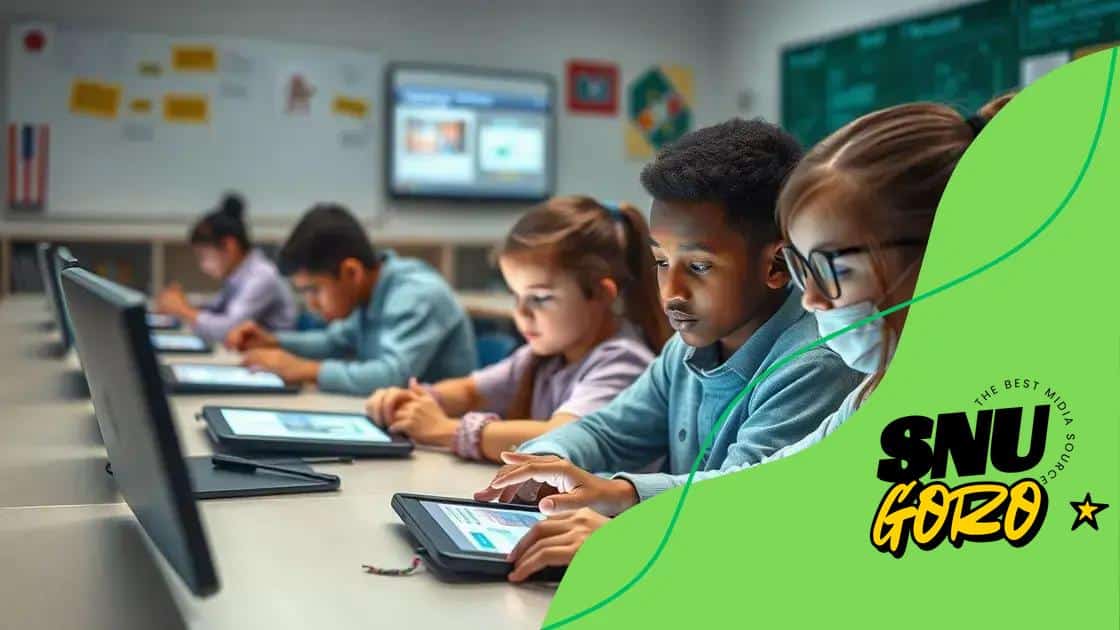AI in special education support: transforming learning

AI in special education support enhances personalized learning by providing tailored resources, automating tasks for teachers, and improving engagement, thus creating more inclusive learning environments for students with disabilities.
AI in special education support is changing the way educators approach learning challenges. Imagine a classroom where each student’s unique needs are met through tailored strategies—this is becoming a reality with AI. Let’s explore how these advancements can make a difference.
Understanding the role of AI in education
Understanding the role of AI in education is essential in today’s learning environment. With the rapid advancement of technology, AI offers powerful tools that can enhance educational experiences for both teachers and students.
AI systems can analyze vast amounts of data quickly, allowing educators to tailor instruction to meet individual student needs. This personalization is especially crucial for students facing challenges in traditional learning settings.
How AI Personalizes Learning
By utilizing AI, educators can identify specific areas where students struggle and provide targeted support. For example, AI can:
- Analyze student performance data
- Provide real-time feedback
- Suggest personalized learning paths
- Adapt resources to fit diverse learning styles
This adaptability makes learning more accessible and engaging, enabling students to progress at their own pace. Moreover, AI can assist teachers by automating administrative tasks, freeing up valuable time for direct student interaction.
The Impact of AI Tools in the Classroom
AI tools are revolutionizing the classroom environment, making it more interactive and inclusive. These tools can range from intelligent tutoring systems to educational games that adjust difficulty based on the learner’s understanding. Such innovations promote active engagement, encouraging students to take ownership of their learning.
These benefits highlight the growing importance of incorporating AI in special education support. With many students requiring unique approaches, AI provides the ability to create and implement strategies that are not only efficient but effective. When students receive the support they need, they’re more likely to succeed academically and socially.
Benefits of AI for students with disabilities
The benefits of AI for students with disabilities are significant and transformative. AI technologies can provide real-time support that tailors learning experiences to meet individual needs, making education more inclusive.
For instance, with AI, students can receive personalized learning materials that cater to their unique challenges. This can lead to improved engagement and motivation in the classroom.
Key Advantages of AI in Special Education
There are various ways that AI can enhance the educational experience for students with disabilities:
- Customized Learning Experiences: AI can adapt lessons to fit various learning styles, ensuring that each student progresses at their own pace.
- Accessibility Features: Software powered by AI can assist with reading, writing, and communication, providing tools like speech recognition for those who may struggle with traditional methods.
- Immediate Feedback: AI systems offer prompt responses to student inquiries, helping them to understand concepts more quickly.
- Emotional Support: Some AI tools incorporate social-emotional learning, providing students with resources to develop emotional intelligence.
These advancements show how AI can remove barriers and create equal opportunities for success. For example, students who once faced significant difficulties can now thrive in an environment that respects their individual needs.
Moreover, teachers equipped with AI tools can significantly reduce their workload. This allows them to focus more on interactive teaching and less on administrative tasks, ultimately creating a richer educational experience.
How AI tools enhance personalized learning

How AI tools enhance personalized learning is a vital topic in today’s educational landscape. By leveraging technology, educators can create tailor-made learning experiences that focus on the unique needs of each student.
AI tools are designed to analyze data efficiently, allowing for insights that can shape individualized instruction. This means that students can receive support that specifically addresses their strengths and areas for improvement.
The Role of AI in Personalization
Through AI, students benefit from:
- Adaptive Learning Platforms: These platforms adjust content difficulty based on real-time assessments, ensuring that students are always challenged but not overwhelmed.
- Intelligent Tutoring Systems: These systems provide one-on-one assistance, helping students understand complex subjects at their own pace.
- Targeted Feedback: AI can offer immediate suggestions and corrections, allowing students to learn from mistakes without delay.
- Resource Recommendations: By analyzing a student’s learning habits, AI can suggest relevant materials that align with their interests and needs.
This personalized approach not only aids students in grasping challenging concepts but also fosters a love for learning. When education feels tailored, students are more likely to engage deeply and persist in their studies.
Furthermore, teachers can utilize AI data to plan lessons that cater to diverse learning styles. By understanding which methods work best for each student, educators can enhance classroom interactions and student satisfaction.
As technology evolves, the integration of AI in special education support becomes increasingly valuable. Students who might struggle in traditional settings benefit immensely from these innovations, finding pathways to success that were previously inaccessible.
Success stories of AI in special education
Success stories of AI in special education highlight the transformative power of technology in the classroom. Many students with disabilities have benefitted from innovative AI solutions that address their unique needs.
One such success comes from a school district that implemented an AI-driven reading program. This program uses speech recognition and contextual learning to help students struggling with literacy. The results were remarkable, with many students improving their reading levels significantly over just a few months.
Real-World Examples of AI Impact
Various schools around the world are sharing their positive experiences with AI:
- Personalized Learning Apps: A special education class used an AI app that adapts to each student’s learning pace. This allowed students to tackle challenges they previously found overwhelming.
- Resource Allocation: AI systems provided teachers with insights to allocate resources effectively. By understanding each student’s needs, teachers could offer targeted support during lessons.
- Behavioral Support: In another instance, AI-driven behavioral tracking tools helped teachers monitor students’ emotions and actions. This data was crucial in modifying approaches to maintain a positive learning environment.
- Remote Learning Enhancements: During lockdowns, AI technologies like virtual tutoring provided necessary support to students. Many adapted quickly and continued their studies without disruption.
As these stories illustrate, the integration of AI in special education not only enhances learning but also empowers students. By creating environments where students feel understood and supported, schools can foster resilience and success.
Moreover, these success stories underscore the importance of continued investment in AI solutions. As more schools recognize the benefits, the landscape of education for students with disabilities will continue to improve.
Future trends of AI in educational support
Future trends of AI in educational support promise to shape the learning environment in exciting ways. As technology advances, AI will continue to enhance how educators deliver instruction and support students.
One significant trend is the rise of intelligent tutoring systems. These systems use AI to provide personalized instruction that adapts to each learner’s style and pace. As these technologies improve, we can expect more tailored experiences that cater to individual student needs.
Innovations on the Horizon
Several innovations are emerging in the realm of AI in education:
- Emotion Recognition: AI technologies are being developed to analyze facial expressions and voice tones. This can help educators understand students’ emotions and adjust their teaching strategies accordingly.
- Advanced Analytics: AI will provide deeper insights into student performance. This data will help teachers identify learning gaps and offer targeted interventions.
- Collaborative Learning Tools: Future AI tools will further enhance collaborative learning by connecting students across various environments, allowing them to work together effectively regardless of their location.
- Gamification: AI-driven gamified learning experiences will continue to grow. The use of games can make learning more engaging, motivating students to participate actively.
As we consider the future, integrating AI in special education support will be crucial. By developing solutions that understand and respond to the unique challenges faced by students with disabilities, we can create a more inclusive educational landscape.
Additionally, the focus on teacher support will expand. AI is expected to assist educators by automating administrative tasks, enabling them to spend more time engaging with students and fostering effective learning environments.
FAQ – Frequently Asked Questions about AI in Educational Support
How does AI personalize learning for students?
AI adapts lessons to fit the individual needs and paces of students, providing customized resources and support.
What are some success stories of AI in special education?
Many schools report improved engagement and learning outcomes for students with disabilities through the use of AI tools.
How can AI assist teachers in the classroom?
AI can automate administrative tasks, analyze student data, and provide insights, allowing teachers to focus more on direct instruction.
What future trends can we expect in AI and education?
Future trends include advancements in emotion recognition, intelligent tutoring systems, and gamified learning experiences that enhance engagement.





